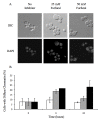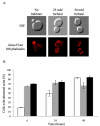Furfural induces reactive oxygen species accumulation and cellular damage in Saccharomyces cerevisiae
- PMID: 20150993
- PMCID: PMC2820483
- DOI: 10.1186/1754-6834-3-2
Furfural induces reactive oxygen species accumulation and cellular damage in Saccharomyces cerevisiae
Abstract
Background: Biofuels offer a viable alternative to petroleum-based fuel. However, current methods are not sufficient and the technology required in order to use lignocellulosic biomass as a fermentation substrate faces several challenges. One challenge is the need for a robust fermentative microorganism that can tolerate the inhibitors present during lignocellulosic fermentation. These inhibitors include the furan aldehyde, furfural, which is released as a byproduct of pentose dehydration during the weak acid pretreatment of lignocellulose. In order to survive in the presence of furfural, yeast cells need not only to reduce furfural to the less toxic furan methanol, but also to protect themselves and repair any damage caused by the furfural. Since furfural tolerance in yeast requires a functional pentose phosphate pathway (PPP), and the PPP is associated with reactive oxygen species (ROS) tolerance, we decided to investigate whether or not furfural induces ROS and its related cellular damage in yeast.
Results: We demonstrated that furfural induces the accumulation of ROS in Saccharomyces cerevisiae. In addition, furfural was shown to cause cellular damage that is consistent with ROS accumulation in cells which includes damage to mitochondria and vacuole membranes, the actin cytoskeleton and nuclear chromatin. The furfural-induced damage is less severe when yeast are grown in a furfural concentration (25 mM) that allows for eventual growth after an extended lag compared to a concentration of furfural (50 mM) that prevents growth.
Conclusion: These data suggest that when yeast cells encounter the inhibitor furfural, they not only need to reduce furfural into furan methanol but also to protect themselves from the cellular effects of furfural and repair any damage caused. The reduced cellular damage seen at 25 mM furfural compared to 50 mM furfural may be linked to the observation that at 25 mM furfural yeast were able to exit the furfural-induced lag phase and resume growth. Understanding the cellular effects of furfural will help direct future strain development to engineer strains capable of tolerating or remediating ROS and the effects of ROS.
Figures






Similar articles
-
Overexpression of the yeast transcription activator Msn2 confers furfural resistance and increases the initial fermentation rate in ethanol production.J Biosci Bioeng. 2012 Apr;113(4):451-5. doi: 10.1016/j.jbiosc.2011.11.017. Epub 2011 Dec 16. J Biosci Bioeng. 2012. PMID: 22178024
-
Identification of furfural resistant strains of Saccharomyces cerevisiae and Saccharomyces paradoxus from a collection of environmental and industrial isolates.Biotechnol Biofuels. 2015 Feb 26;8:33. doi: 10.1186/s13068-015-0217-z. eCollection 2015. Biotechnol Biofuels. 2015. PMID: 25861389 Free PMC article.
-
Contribution of YPRO15C Overexpression to the Resistance of Saccharomyces cerevisiae BY4742 Strain to Furfural Inhibitor.Pol J Microbiol. 2023 Jun 14;72(2):177-186. doi: 10.33073/pjm-2023-019. eCollection 2023 Jun 1. Pol J Microbiol. 2023. PMID: 37314359 Free PMC article.
-
Genomic adaptation of ethanologenic yeast to biomass conversion inhibitors.Appl Microbiol Biotechnol. 2006 Nov;73(1):27-36. doi: 10.1007/s00253-006-0567-3. Epub 2006 Oct 7. Appl Microbiol Biotechnol. 2006. PMID: 17028874 Review.
-
Molecular and physiological basis of Saccharomyces cerevisiae tolerance to adverse lignocellulose-based process conditions.Appl Microbiol Biotechnol. 2019 Jan;103(1):159-175. doi: 10.1007/s00253-018-9478-3. Epub 2018 Nov 5. Appl Microbiol Biotechnol. 2019. PMID: 30397768 Review.
Cited by
-
Transcriptional analysis of Clostridium beijerinckii NCIMB 8052 to elucidate role of furfural stress during acetone butanol ethanol fermentation.Biotechnol Biofuels. 2013 May 4;6(1):66. doi: 10.1186/1754-6834-6-66. Biotechnol Biofuels. 2013. PMID: 23642190 Free PMC article.
-
Microbial degradation of furanic compounds: biochemistry, genetics, and impact.Appl Microbiol Biotechnol. 2011 Dec;92(6):1095-105. doi: 10.1007/s00253-011-3632-5. Epub 2011 Oct 28. Appl Microbiol Biotechnol. 2011. PMID: 22031465 Free PMC article. Review.
-
High vanillin tolerance of an evolved Saccharomyces cerevisiae strain owing to its enhanced vanillin reduction and antioxidative capacity.J Ind Microbiol Biotechnol. 2014 Nov;41(11):1637-45. doi: 10.1007/s10295-014-1515-3. Epub 2014 Sep 28. J Ind Microbiol Biotechnol. 2014. PMID: 25261986
-
Overexpression of Oxidoreductase YghA Confers Tolerance of Furfural in Ethanologenic Escherichia coli Strain SSK42.Appl Environ Microbiol. 2021 Nov 10;87(23):e0185521. doi: 10.1128/AEM.01855-21. Epub 2021 Sep 29. Appl Environ Microbiol. 2021. PMID: 34586907 Free PMC article.
-
Saccharomyces cerevisiae strains performing similarly during fermentation of lignocellulosic hydrolysates show pronounced differences in transcriptional stress responses.Appl Environ Microbiol. 2024 May 21;90(5):e0233023. doi: 10.1128/aem.02330-23. Epub 2024 Apr 8. Appl Environ Microbiol. 2024. PMID: 38587374 Free PMC article.
References
-
- Bothast J, Saha B. Ethanol production from agricultural biomass substrates. Adv Appl Microbiol. 1997;44:261–286.
-
- Palmqvist E, Hahn-Hägerdal B. Fermentation of lignocellulosic hydrolysates. II: inhibitors and mechanisms of inhibition. Bioresour Technol. 2000;74:25–33. doi: 10.1016/S0960-8524(99)00161-3. - DOI
LinkOut - more resources
Full Text Sources
Molecular Biology Databases

